Contact us
LED Video Processor Guide: Functions, Tips & Top Models
The global appetite for immersive visual experiences is growing faster than ever. According to the latest 2025 market analysis, the global LED video wall market is projected to skyrocket, with forecasts predicting it will reach approximately US$ 15-25 billion by 2032, growing at a robust CAGR of over 11%. From Times Square-style outdoor billboards to ultra-fine pitch control room displays, the hardware is getting bigger, brighter, and sharper. But as screen technology leaps forward, it exposes a critical weak link in many setups: the LED video processor.
At UnifyLED, we see this every day. A state-of-the-art screen connected to an outdated processor is like a Ferrari engine inside a go-kart. To truly capitalize on this market boom, your display needs a “brain” that can keep up.
Table of Contents
1. What Does a LED Video Processor Actually Do for Your Screen?
While the LED screen acts as the “canvas,” the video processor acts as the “artist.” It is responsible for ensuring that the content you input looks perfect on the display. Here are the four critical functions it performs:
Image Scaling
Unlike LCD TVs or monitors that auto-adjust, LED screens utilize a point-to-point display method. This means the screen strictly displays pixels one-to-one.
The Function: The video processor scales your image—whether zooming in or out—to map the content exactly to the LED screen’s physical resolution.
The Benefit: It ensures the entire desktop map is visible and fills the screen perfectly, regardless of whether the input resolution is higher (4K) or lower (720p) than the screen itself.
Signal Conversion & Seamless Switching
In real-world scenarios, especially events, you rarely use just one type of cable. Control cards typically use DVI or HDMI, but your sources might be cameras (SDI), media servers (DP), or other electronics.
The Function: The processor acts as a universal bridge, converting various format signals into a unified signal that the LED sending card can understand.
The Benefit: It manages multiple inputs simultaneously and allows for flexible switching. Professional processors ensure this switch is seamless (no black screen or glitches) when cutting between a camera feed and a computer slide.
Image Quality Enhancement
Because the pixel pitch of an LED screen is physically larger than other display media, visual defects like noise and jagged edges are more noticeable.
The Function: High-quality processors employ advanced algorithms to “clean up” the signal. This includes edge sharpening, motion compensation, and noise reduction.
The Benefit: It creates a crisp, stable image with richer details, making even lower-quality video sources look professional on a large wall.
Multi-Screen Processing (Splicing)
As LED screens grow larger—often exceeding standard 4K resolutions—a single sending card may not be enough to drive the whole wall.
The Function: The processor features splicing capabilities, allowing it to split a massive image across multiple outputs to drive an ultra-large resolution screen.
The Benefit: It allows for complex display setups, such as displaying one huge image across a giant stage background, or using Picture-in-Picture (PIP) to show multiple different signal windows on the same screen simultaneously.
2. How Do You Choose the Perfect LED Video Processor for Your Screen?
With hundreds of models on the market, selecting the right processor can be overwhelming. To ensure you don’t overspend on unnecessary features or under-spec your equipment, consider these 7 key factors:
Loading Capacity
The most critical parameter is the Maximum Output Resolution. Your processor’s capacity must be greater than or equal to your screen’s total pixel count.
Standard (2K): For typical screens, look for support up to 1920×1080 or 2.3 million pixels.
Ultra-Wide/High: For irregular screens, ensure the processor supports custom resolutions (e.g., 3840×1080).
4K Ultra-HD: For fine-pitch screens (P1.2 – P2.5), you need a processor capable of 3840×2160 or 8.8 million pixels.
Pro Tip: Always leave a little “headroom” in the loading capacity for future expansion.
Interface & Format Support
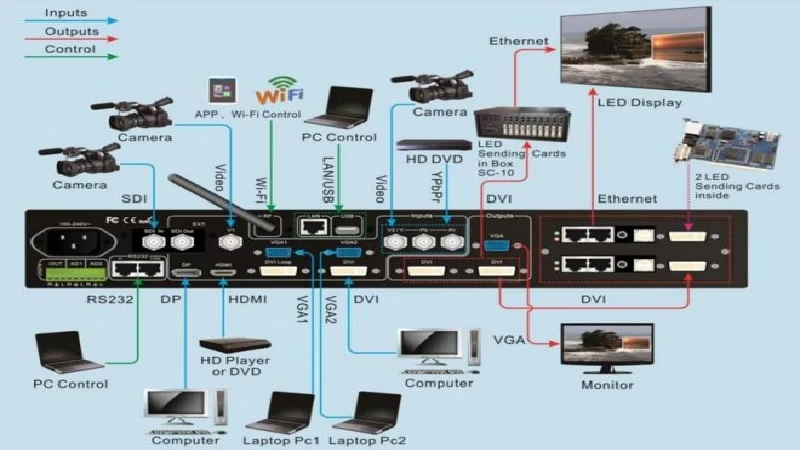
Don’t get stuck with the wrong cables. Choose a processor that matches your video sources:
Essential: HDMI 2.0 and DP 1.2 (for high-resolution computer signals).
Broadcast Professional: If you are using professional cameras for live events, look for 3G-SDI or 12G-SDI inputs.
Note: Legacy formats like VGA or S-Video are rarely used in modern LED setups, so focus on high-bandwidth digital interfaces.
Image Enhancement Technology
A high-end processor does more than just transmit signals; it beautifies them.
Look for: Features like HDR (High Dynamic Range) support, 10-bit color depth, and scaling algorithms (like Super Resolution).
Why it matters: As UnifyLED screens move towards Mini-LED and Micro-LED, the improved grayscale and color accuracy provided by premium processors (e.g., Novastar COEX or Magnimage) are essential for visual impact.
Switching Speed & Effects
In a live event, a black screen is a disaster.
Basic: Direct switching (Cut). Good for simple ads, but may have a split-second delay.
Professional: Seamless Switching with Fade-in/Fade-out effects. This ensures smooth transitions between inputs, essential for concerts and conferences.
Advice: For rental projects, seamless switching is a “must-have” feature.
Multi-Window Capabilities (Layers)
Do you need to show just one image, or multiple images at once?
Standard: Single window display.
Advanced: PIP (Picture-in-Picture) or POP (Picture-outside-Picture). High-end processors support 3, 4, or even more distinct layers, allowing you to display a PPT, a live camera feed, and a logo simultaneously.
Note: The more layers you need, the higher the cost.
Brand Selection
Quality varies significantly between brands. At UnifyLED, we partner with industry leaders to ensure stability:
Global Leaders: Barco, Extron (Best for ultra-high-end integration).
Top Tier LED Specialists: Novastar, Colorlight, Magnimage, VDWall, RGBLink.
Our Recommendation: For 90% of LED projects, brands like Novastar and VDWall offer the best balance of performance, stability, and price.
The "All-in-One" Solution (The Modern Trend)
Traditionally, you needed a Video Processor + a separate Sending Card.
The Problem: More cables, more boxes, higher cost.
The Solution: The All-in-One Controller. Devices like the Novastar VX series (VX400, VX600, VX1000) or Linsn X series integrate the processor and sending card into a single unit.
Benefit: They are cheaper, easier to configure, and save rack space. This is now the standard choice for fixed installations and small-to-medium rental events.
3. Top Recommended All-in-One Processors
At UnifyLED, we prioritize stability and performance. Based on our latest testing, here are the standard models we recommend for most fixed and rental installations.
Novastar VX Series (The Industry Standard)
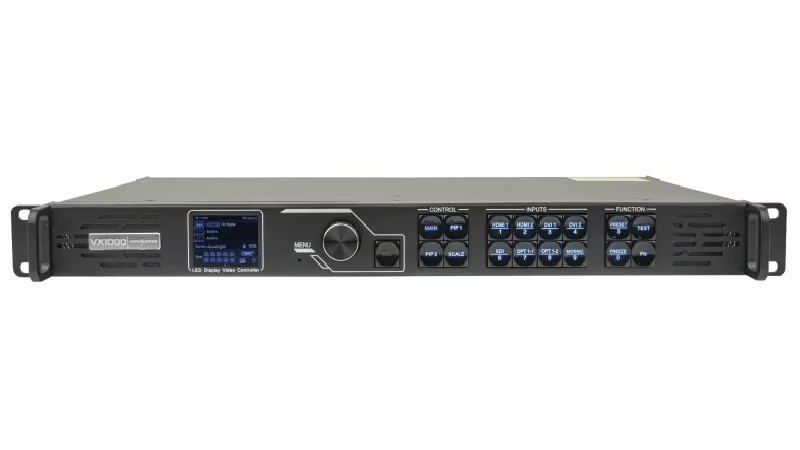
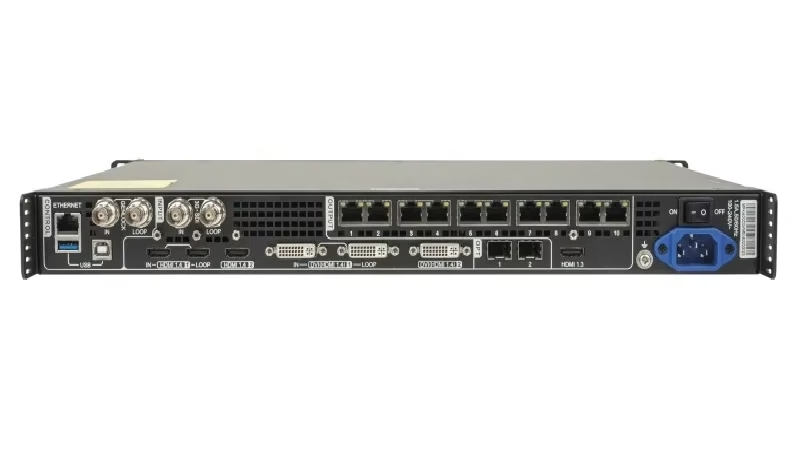
Novastar’s new VX series has replaced the older VX4S-N/VX400s. They now feature better scaling algorithms, higher loading capacities, and fiber optic support as standard.
| Model | Loading Capacity | Max Output Width / Height | Inputs | Ethernet Outputs | UnifyLED Verdict |
| VX400 | 2.6 Million | 10,240 / 8,192 | HDMI 1.3 ×1<br>DVI ×1<br>3G-SDI ×1 (Optional)<br>OPT ×1 | 4 Ports | Best Seller. Perfect for small to medium events and retail screens. |
| VX600 | 3.9 Million | 10,240 / 8,192 | HDMI 1.3 ×2<br>DVI ×1<br>3G-SDI ×1<br>OPT ×2 | 6 Ports | The Sweet Spot. Ideal for wider screens that slightly exceed 1080p resolution. |
| VX1000 | 6.5 Million | 10,240 / 8,192 | HDMI 1.4 ×2<br>DVI ×2<br>3G-SDI ×1<br>OPT ×2 | 10 Ports | High Performance. Capable of driving 4K screens (up to 4096 width) easily. |
Note: The new VX series supports stepless output scaling and color correction, making them superior to the older generations.
Huidu VP Series (The Smart Commercial Choice)
Best for: Retail Stores, Outdoor Billboards, Shop Windows.
Huidu (HD) processors are famous for their “Asynchronous/Synchronous Dual Mode.” They support USB Drive Playback and Wi-Fi Control (Mobile App), meaning you don’t need to keep a computer connected to the screen 24/7.
| Model | Loading Capacity | Max Resolution | Inputs & Features | Ethernet Outputs | Recommended Application |
| HD-VP210 | 1.3 Million | 3840 / 1920 | HDMI, VGA, USB<br>Wi-Fi Support | 2 Ports | Entry-level shop banners or door-head screens. |
| HD-VP410 | 2.6 Million | 3840 / 1920 | HDMI, DVI, VGA, USB<br>U-disk Playback | 4 Ports | Standard indoor/outdoor fixed advertising screens. |
| HD-VP820 | 5.2 Million | 8192 / 4000 | HDMI, DVI, VGA, USB<br>Mobile App Control | 8 Ports | Large format outdoor billboards. |
| HD-VP1240 | 7.8 Million | 8192 / 4000 | HDMI, DVI, DP<br>4-Layer Display | 12 Ports | Ultra-wide commercial video walls. |
UnifyLED's Buying Advice: Novastar or Huidu?
Choose Novastar if:
You need SDI inputs for live cameras.
The screen is for a stage event where latency must be zero.
You are using professional mapping software (NovaLCT).
Choose Huidu if:
The screen is for advertising (storefront, shopping mall).
You want to plug in a USB stick to play videos (no PC required).
You want to control the screen brightness or switch programs using your phone (Mobile App).
Still not sure which one fits your project?
Let us know your application scenario (Stage or Store?), and UnifyLED will configure the perfect processor for you.
4. FAQs
Not with UnifyLED. We pre-configure the LED video processor software (such as Novastar LCT or VDWall software) before shipping. When you receive it, it's usually Plug-and-Play.
Yes, there are many led video processors on the market, but compatibility is key. We ensure the processor matches the receiving cards in your panels.
Usually, no. Simple signs can use asynchronous cards. But for full-color video walls, a processor is essential.
5. Let UnifyLED Configure the Right LED Video Processor for You
Choosing the right hardware can be overwhelming. There are technical specifications to consider, such as loading capacity, input interfaces, and resolution limits.
You don’t need to become a hardware expert. That’s our job.
At UnifyLED, we don’t just sell panels; we design the entire signal flow. Whether you need a simple synchronous system or a high-end LED video processor, we will configure the solution that fits your budget and ensures your screen looks its best from day one.
Not sure if your project needs a processor? Contact UnifyLED today for a free system diagram and consultation.
6. Recommend
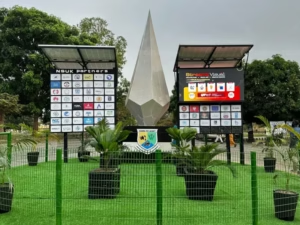
Nits vs. Lumens: Why Your Projector Can’t Beat an LED Screen?
Nits vs. Lumens: Demystifying brightness. See why LED screens beat high-lumen projectors in daylight. Learn the key difference and choose the right display.
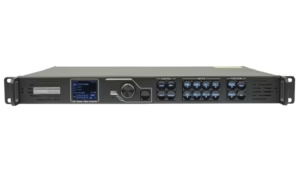
LED Video Processor Guide: Functions, Tips & Top Models
Learn how a led video processor enhances your screen. Explore functions, selection tips, and top Novastar VX vs Huidu VP recommendations.
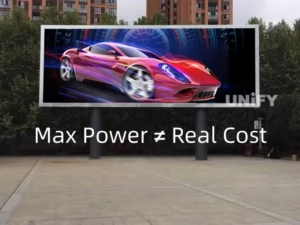
LED Display Power Consumption Guide: Watts, Amps & Cost Calculator
Master led display power consumption calculations. Learn the real difference between Max vs. Average watts and save your budget.
